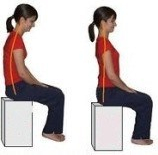
How many times have we heard “Stand in Singer’s Posture” or “Pull Your Sternum Toward the Ceiling”? And so, tall I stood. Staying in perfect posture took hold when I was but fourteen years old and effected me until just a few years ago. When I was an impressionable fourteen years old someone gave me a compliment. The compliment was that I had great posture. I took note of what I was doing when that person made the comment. Since then, I have always made an effort to sit and stand tall! This is exactly what we want as a singer, right?

I have had several excellent voice teachers over the years that have taught me many great vocal techniques and meaningful repertoire. But, I have had one issue with my voice that has always been a mystery. Now that I understand what caused the symptoms, I wonder why it was not so apparent from the beginning. It was a former professional dancer that led me to discover the most important element missing in my singing.
When I would perform with the William Baker Festival Singers I experienced pain emanating from my back within the first few minutes. It wasn’t because we were holding folders, because we sang from memory. By the time we were half way through, I would begin to experience vocal fatigue. This was not my experience in rehearsals. Was it the floor I was standing on? Was it the stress of giving a high stakes performance from memory? But, when I was conducting my own Festival Singers, I noticed a difference. I experienced no pain during or after any performance no matter the length. As a matter of fact, I felt great!
For years, many people weighed in on this issue and offered their remedy:
Attempted Solution #1: After discussing this phenomenon with one of my voice teachers he explained that I should lift my rib cage out of my hips, tuck my tail bone and “lower” into my thighs causing my knees to slightly bend. He recommended that I hold this position while I sing. How can one hold any position while singing? You can imagine that maintaining this position for even a couple of minutes was more exhausting than dealing with the sway back issue.
Attempted Solution #2: Recommended to me by other vocal pedagogues, I should sway slightly while singing. This would increase circulation and therefore keep tension from setting in thus enabling better air flow. This helped relieve some of the tension in my back, but it did little for vocal stamina.
Attempted Solution #3: Stand on a gel mat and change your shoes! I’ve never been able to stand in high-heels because my ankles are made of rubber (which is why I majored in organ). But, I did try various shoes with different degrees of arch support, heel cushions, all to no avail. I even tried rubbing magnesium in these areas. The gel mat was nice, bud didn’t resolve the problem.
Final ReSolution: The dancer that guided me to resolve to understand the source of my issue was Babette Lightner. After talking with her a few minutes at Voice Care Network , she asked me to sing. I immediately got ready to sing by assuming singer posture. She asked me how I felt. I assessed and said “tight and thin”. Then, with no comment, she asked me to sing and walk about the room, gazing upon different things – the windows, the plants, the lights. She asked me how I felt. I responded with “great!” She asked me again to stand still and sing. Back into singer posture I went. She asked yet again what was different. What is different about walking and singing (while not thinking about it) and standing still and singing? It couldn’t just be the movement, because I had tried that before. It was something more. All these years I had come to believe that standing tall was something you had to manipulate your body to do, that posture was something to be held in place.
But, standing tall meant over-extending my sternum. It meant pulling my sternum up and out. This actually increased the bow in my sway back. This over-reaching position displaced my diaphragm so that it could not collapse or expand freely and completely. All this time, I thought my stamina and breathing issues stemmed from or my sway back. My issue with being able to sing well were created from my idea of a singer’s posture.
 Lumbar Lordosis or Sway Back
Lumbar Lordosis or Sway Back
Now when I sing, I just stand. If I can look all about the room turning my neck without creating tension, then I know I can sing. If I know I can move left to right and front to back, if I can touch my head, the back of my neck, if I can draw elephant ears in the sky, then I can sing.
It’s true that our bodies are not meant to stand still. We cannot hold any position because our bodies are not meant to assume positions. As a part of avoiding the protrusion of my sternum, I also listen to my heart beat and the pulse of the music. With that, I am able to move because I am using my mind and my body as one. And with that, I am able to be singer and not a mechanic.
Is this you?

maybe instead, you can do this while you sing . . .

maybe your choir could feel free to move:
St. Olaf Choir College sing Wondrous Love, Southern Harmony, arr. Robert Scholz. Anton Armstrong, Conductor.
To understand more about our bodymind systems, please read more:
Babette Lightner: The Lightner Method
David Gorman: Learning Methods
A Virtuous Circle – Empowering the Wholeness and Body of Well-Being in Rehearsal: http://www.lightnermethod.com/uploads/8/5/6/1/85610178/acda_2017.pdf
David Gorman: Learning Methods Library
References


Leave a Reply
You must be logged in to post a comment.